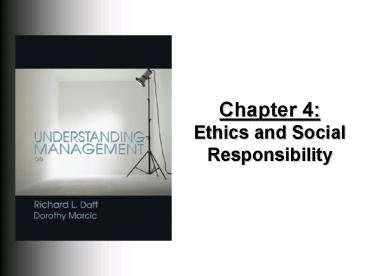Chapter 4: Ethics and Social Responsibility - PowerPoint PPT Presentation
1 / 24
Title:
Chapter 4: Ethics and Social Responsibility
Description:
Ethical Dilemma. Right and wrong cannot be clearly identified ... Most ethical dilemmas involve conflict between needs of the part & whole ... – PowerPoint PPT presentation
Number of Views:97
Avg rating:3.0/5.0
Title: Chapter 4: Ethics and Social Responsibility
1
Chapter 4Ethics and Social Responsibility
0
2
Learning Objectives
0
- Define ethics and explain how ethical behavior
relates to behavior governed by law and free
choice. - Explain the utilitarian, individualism,
moral-rights, and justice approaches for
evaluating ethical behavior. - Describe how both individual and organizational
factors shape ethical decision making. - Define corporate social responsibility and how to
evaluate it along economic, legal, ethical, and
discretionary criteria. - Describe four organizational approaches to
environmental responsibility, and explain the
philosophy of sustainability. - Discuss how ethical organizations are created
through ethical leadership and organizational
structures and systems. - Identify important stakeholders for an
organization and discuss how managers balance the
interests of various stakeholders.
3
Ethics
0
- The code of moral principles and values that
govern the behaviors of a person or group with
respect to what is right or wrong.
4
Three Domains of Human Action
0
Domain of Codified Law (Legal Standard)
Domain of Ethics (Social Standard)
Domain of Free Choice (Personal Standard)
Amount of
Explicit Control
High
Low
Exhibit 5.1
Ethics lies between these domains.
5
Ethical Dilemma
0
- Right and wrong cannot be clearly identified
- All choices or alternatives are undesirable
6
Criteria For Ethical Decision Making
0
- Most ethical dilemmas involve conflict between
needs of the part whole - Individual versus the organization
- Organization versus society as a whole
- Managers benefit from a normative strategy to
guide their decision making - Norms and values
7
Ethical Decision Making Approaches
0
- Utilitarian Approach
- Individualism Approach
- Moral-Rights Approach
- Justice Approach
8
Utilitarian Approach
0
- Moral behavior produces the greatest good for the
greatest number - Focus on decisions that optimize the satisfaction
for the greatest number of people
9
Individualism Approach
0
- Acts promote the individual's best long-term
interests, which ultimately leads to the greater
good - Individual self-direction paramount
- Individualism is believed to lead to honesty
integrity since that works best in the long run
10
Moral-Rights Approach
0
- Maintain the rights of those affected
- Avoid interfering with the fundamental rights of
others.
11
Six Moral Rights
0
1. The right of free consent
2. The right to privacy
3. The right of freedom of conscience
4. The right of free speech
5. The right to due process
6. The right to life and safety
12
Justice Approach
0
Moral decisions are based on standards of equity,
fairness, impartiality
- Three types of Justice Approaches
- Distributive Justice
- Procedural Justice
- Compensatory Justice
13
Three Types of Justice
0
Distributive Justice different treatment of
people should not be based on arbitrary
characteristics.
Procedural Justice rules should be administered
fairly and enforced consistently and impartially.
Procedural Justice individuals should be
compensated for the cost of their injuries by the
party responsible.
14
Factors Affecting Ethical Choices
0
The Manager
The Organization
15
Levels of Personal Moral Development
0
Exhibit 4.2
16
The Organization
0
- Values adopted within the organization are highly
important - Most people believe their duty is to fulfill
obligations and expectations of others - Corporate culture provides a framework of beliefs
and behaviors the company supports - or will not tolerate
17
Corporate Social Responsibility
0
- Decisions and actions that will enhance the
welfare and interests of society and the
organization - Being a good corporate citizen
- Ambiguous issues can make social responsibility
hard to grasp
18
Organizational Stakeholders
0
- Any group within or outside the organization that
has a stake in the organizations performance
19
Stakeholders at Monsanto Company
Exhibit 4.5
20
The Ethics of Sustainability and The Environment
0
The Shades of Corporate Green
Exhibit 4.6
21
Evaluating CorporateSocial Responsibility
0
Exhibit 4.7
22
The Ethical Organization
0
The Three Pillars of an Ethical Organization
Exhibit 4.9
23
Code of Ethics
A formal statement of the organizations values
regarding ethics and social issues.
24
Ethics in Turbulent Times
- Many companies today employ systems, positions
and programs to support ethics - Ethics Committee
- Chief Ethics Officer
- Ethics Training
- Whistle-blowing has become an encouraged strategy
- There is growing business case and demand for
ethics and social responsibility































